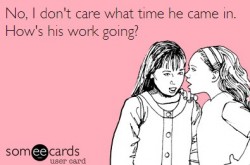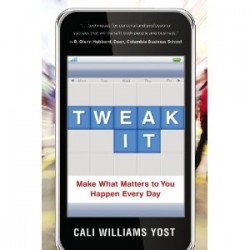I had put it off for as long as I could, and it was time to finally bite the bullet and get it done. I sent a message to my manager and told him that I was going to work from home the following day in order to knock a few things off my list. I knew others on the team did it occasionally, but it felt weird staying home instead of making the daily commute. And you know what? I really liked it. I actually got more done from home, accomplishing all of my key “to do” items and a few more. I was less stressed and felt satisfied for the first time in a while by the time I returned to the office the following day.
—–
I can still remember sitting in front of my computer that day all those years ago. I remember how I felt, what I was working on, and what the results were. I tell the story because it is a perfect example of what people are saying about how they get work done.
A Quick Primer on the ROWE
I realize that some of you might be newbies to the “ROWE” term, so let me break it down for you. The idea of a ROWE (Results Only Work Environment) is fairly simple: you work when, where, and how you want to–as long as you get the job done. In other words, the place and method don’t really matter, but the results are more important than ever.
The point that ties in here is a core tenet of the ROWE movement: work is a thing you do, not a place you go.
If this sounds intriguing, I’ve written fairly extensively on the topic if you want to explore:
- How to Implement a ROWE
- Flexible Schedule Policy vs Core Business Hours
- Analytics and Business Accountability
- Employee Productivity Management (Video)
People Least Productive in the Office
The title for this post reflects the latest FlexJobs survey, which shows that just 7% of workers think they are most productive in the office. Ouch.
This is a reflection of the open office floor plan debate that has been going on for a few years now. People are just not able to focus, concentrate, and get things done when they are stacked on top of each other like cord wood. Is that actually a surprise to anyone?
The data actually says that this is a bigger problem than we realize, even if we just look at technology and the interruptions it can provide.
Gloria Mark of the University of California, Irvine, found that the typical office worker gets only 11 minutes between interruptions, and it takes approximately 25 minutes to return to the original task after being interrupted. A further study found that those being interrupted make up to 20% more mistakes than those working in an uninterrupted environment. This makes me wonder what the cost of all this “multitasking” really is!
Know How Your Best Work is Done
Despite this somewhat gloomy outlook, it’s important to know how your best work gets done. Here’s my story.
The truth is that I’m an introvert, and my best work is done when I am in a quiet place where I can concentrate. I simply cannot work in an environment with a lot of noise or mental stimuli. In fact, in my day job I can go for eight hours straight without hearing anyone unless I have a meeting on the calendar. And that is fine with me, because it allows me to focus wholly on the task(s) at hand.
When I think back on my time working in a cubicle environment, I valued it in some ways and despised it in others. I really liked being connected to my staff and being incredibly accessible to them. On the flip side, it was really tough to have private conversations without scheduling a conference room or finding an empty space to connect. In addition, with my focus issues, I was never able to be fully productive since there was pretty much always an employee that wanted to ask a question, tell a story, or just be that chatty person that wandered around all day.
What each of you should do is think about how you work best, block out focused time, and try to minimize distractions that do not add value to your day. I learned a lot about this in the book Two Awesome Hours, which I referenced in a previous post.
Another book that quickly hooked me was Two Awesome Hours. The basic premise is that we were not meant to sit at a computer for eight plus hours a day working at a single repetitive task without breaks. That's what robots are for. Josh Davis, PhD, says some people can get as much done in two good, productive hours as others can in an entire day. The concept has to do with a few different elements of work, but the part that has been most interesting for me is working on focused activities when I'm most “on.â€
Good luck with managing distractions and being productive, my friends!
 I found the results intriguing, because while we say we need accountability first and foremost within our organizations, many leaders often do a poor job of actually communicating that need. Oh, they’ll tell people they need to be accountable, but when it comes down to time to measure performance, they’ll think about things that don’t really tie into accountability for results. Having analytics to drive those sorts of decisions will be a positive overall; however, it will also mean that leaders and managers can no longer rely on other unimportant “measures” of performance.
I found the results intriguing, because while we say we need accountability first and foremost within our organizations, many leaders often do a poor job of actually communicating that need. Oh, they’ll tell people they need to be accountable, but when it comes down to time to measure performance, they’ll think about things that don’t really tie into accountability for results. Having analytics to drive those sorts of decisions will be a positive overall; however, it will also mean that leaders and managers can no longer rely on other unimportant “measures” of performance. Let me start by saying that if I could flip a switch and turn my employer into a ROWE, I would do it. In essence, a ROWE means that staff work when they want, where they want, and as long as they are getting the results, the rest doesn’t really matter.
Let me start by saying that if I could flip a switch and turn my employer into a ROWE, I would do it. In essence, a ROWE means that staff work when they want, where they want, and as long as they are getting the results, the rest doesn’t really matter.

 I’ve been working with our business development team on a big project. The HR proposal portion is an amazing exercise, because it’s all about us forcing ourselves to quantify the impact that we have on the organization. Sitting there and discussing what differentiates our organization from others in terms of recruiting, retention, etc. opens your eyes to the opportunities that we have to drive change on a high level. It’s helping me to see that our part of the business can be as powerful (or not) as we want it to be.
I’ve been working with our business development team on a big project. The HR proposal portion is an amazing exercise, because it’s all about us forcing ourselves to quantify the impact that we have on the organization. Sitting there and discussing what differentiates our organization from others in terms of recruiting, retention, etc. opens your eyes to the opportunities that we have to drive change on a high level. It’s helping me to see that our part of the business can be as powerful (or not) as we want it to be.